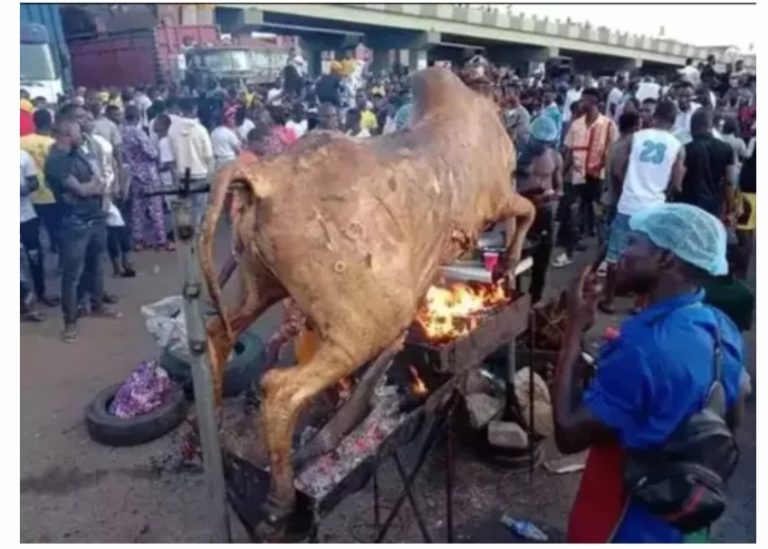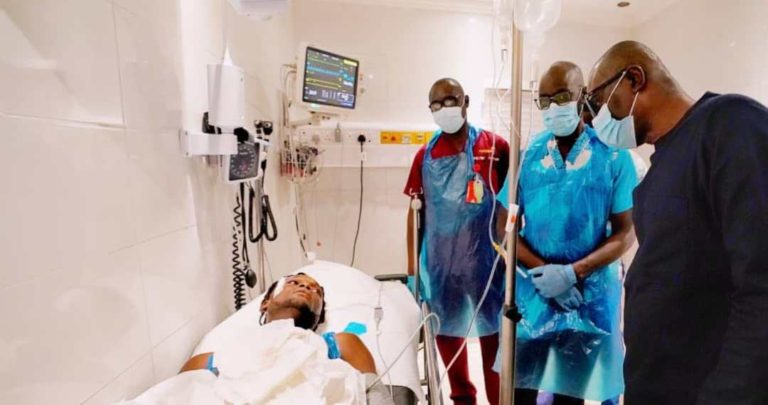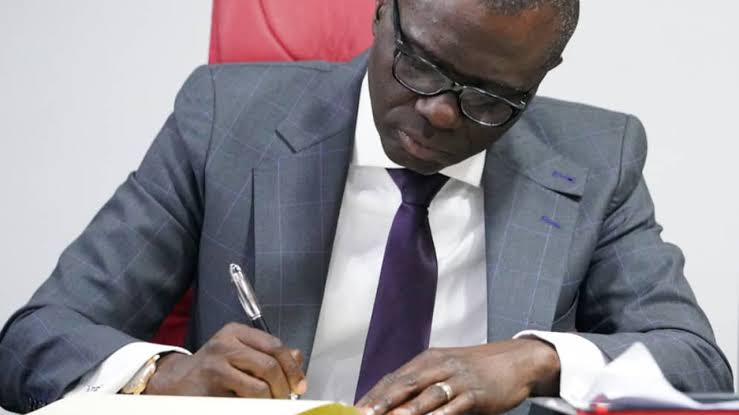▪︎ DSS denies involvement in Abuja video
A disturbing video out of Lagos showing #EndSARS protesters singing the nation’s national anthem while been shot by men alleged to be of the security forces is sparking outrage; as another emerged in Abuja showing persons said to be security agents ferrying alleged pro-SARS out of an attack zone is fervently gaining traction on social media.
In them all, mum is the reaction from the Police and Army, but the Department of State Services (DSS) says its hands are clean over the damning allegations; even as Lagos Governor, Babajide Sanwo-Olu, has ordered investigations into the Lekki Toll Gate shooting, where a former Lagos State Governor is alleged to have huge business interest.
A disturbing video out of Lagos showing #EndSARS protesters
Recall that Miyetti Allah Kautal Hore, a Fulani group, has accused All Progressives Congress chieftain, Asiwaju Ahmed Bola Tinubu, among others, of having a hand in the raging #EndSARS protest because of an alleged presidential ambition in 2023.
The group claims the grand plot is to sack President Muhammadu Buhari, a Fulani.
There are other disturbing videos Everyday.ng cannot share because of their gory nature.
On the Abuja video, an expert told Everyday.ng: “Why are we surprised at this video? It is the business of security forces to employ legitimate and illegitimate means to neutralise protests that threaten the government of the day.
“When they are slow to react like this, it is either that they are behind the protests, or their leadership is in support of the protests. It is why the daughter of former dictator, Sani Abacha, first made the popular comment that when a security situation lasts more than 24 hours, government of the day is complicit.
“Such people, like the ones above, if this video is to be believed, are not the foot-soldiers, they are embedded commanders who direct affairs. May God help us.”
But in a statement, the DSS is exonerating itself from allegations of complicity. Its spokesman, Dr. Peter Afunaya, in a statement said:
“The attention of the Department of State Services (DSS) has been drawn to the fake news making the round that its personnel are aiding pro-SARS supporters and thugs to attack #ENDSARS protesters in Abuja. Part of the untruth being spewed to the public is that some of its officials attached to certain VIPs aided thugs in this regard.
“In view of the false accusations, no DSS personnel has, so far, been identified to be involved in the alleged acts. It begs the question to conclude that SUVs and persons dressed in suits and sighted in conflict environments are of the DSS. Fact is that no staff of the DSS will engage in acts as the ones being peddled by these rumour mongers and hate speakers.
“The Service is a responsible professional Organization and will endeavor to remain so at all times. It, therefore, wishes to state that the allegations leveled against it are not true and can only be taken as false narratives designed to cast it in bad image as well as inflame the protests.
“Consequently, the public is enjoined to disregard the falsehood emanating from sections of the social and mainstream media, subversive groups and interests. The Service uses this opportunity to call on citizens to eschew bitterness, remain law abiding and cooperate with security agencies and indeed, the Government for lasting peace and public safety.”
Meanwhile, enraged leaders of thought, like those in the National Consultative Front,: NCFront, have accused Government of allegedly colluding with thugs and hoodlums to discredit and scuttle popular Youths action
A statement from Olawale Okunniyi, its Head of Secretariat reads “Leaders of Conscience under the aegies of the National Consultative Front, …has condemned the Nigerian government for unleashing a combination of hoodlums brutality and State terror on peaceful protesters in a desperate ploy to undermine, clampdown and scuttle the Peaceful protest initiated by the Nigerian Youths to reform Nigeria
“The NCFront… said from the evidences compiled so far, the Nigerian State and Governments have been exposed as being very reckless and irresponsible in their desperation to scuttle the peaceful protest of the Nigerian Youths, maiming and killing thousand of peaceful Protesters and defenceless Nigerians nationwide
“The NCFront wishes to condemn in the strongest terms, the unstatesmanly panic and jitter betrayed by the Nigerian State and Governments in resorting to propaganda, blackmail, conspiracy and terror to discredit and scuttle the popular peaceful protest of the Nigerian people spearheaded by the EndSars Movement.
“We are indeed very perturbed by the various reactionary tactics and antics employed and deployed by the Nigerian State to discredit, clampdown and scuttle the historic opportunity provided by the Nigerian youths to reform the failed Nigerian State, currently being run as a criminal enterprise and the poverty capital of the world with the teeming Youths of Nigeria bearing the most brunt of terrible state of the country.
“However, given our experience of popular struggle of the people all over the world, the latest antics of the Nigerian government and ruling class to foist erroneous impression that the EndSars protest has gone awry and out of hands inorder to scuttle it with reactionary clampdown and terror can not stop this popular national action, whose time has come as the Nigeria youths and people will have cause to return to the streets soon as their crucial demand to reform and reset Nigeria away from a corrupt and brutal governance system is yet to be met and may have to be pursued henceforth by all Nigerians of conscience, who desire an immediate end to the present exploitative political system in Nigeria
“…we wish to salute and commend the Nigeria youths and the EndSars Movement for the unequalled sacrifices and resolve to liberate our country from State brutality and poverty as we condemn a situation where the Nigerian state collude with hoodlums and thugs to attack, maim, shoot and kill peaceful EndSars protesters nationwide
“This unprecedented State conspiracy and attacks against popular and peaceful action of the Nigerian masses is nothing but uncivilized and wicked, thereby hanging the blood of all those brutalised, maimed, shot and murdered during the EndSars Protest on the head of the Nigerian State. To this end, we call on the Nigerian Youths in Protest against the maiming and killing of their peers to reject government state judicial panels as they are Greek’s gift meant to scam and neutralise the popular struggle initiated to bring about a reformed Nigeria that works for all.
“Finally, we, by this statement, put the international community, especially the United Nations on notice of the human rights crimes committed by the Nigerian Government against peaceful and defenceless Citizens of Nigeria and also call on all Nigerians of Conscience to rise against the latest State brutality and anarchy in Nigeria as the Front will in the succeeding days hold an inclusive meeting of all Leaders of Conscience to review the EndSars Struggle and the way forward.”


















![Kano #EndSARS protesters [PHOTO: TW @Adam_A_Thinker]](https://i1.wp.com/media.premiumtimesng.com/wp-content/files/2020/10/yyyyyyyyyyyyyy.jpg?ssl=1)










